Kongo-Kinshasa |
|
|
|
| Übersicht – Contents: | |
Kongo-Kinshasa |
|
|
|
| Übersicht – Contents: | |
Flagge – Flag: |
|
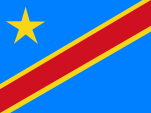 |
Nationalflagge – national flag, Seitenverhältnis – ratio = 3:4, Quelle/Source, nach/by: Wikipedia (D)   |
historische Flaggen – historical Flags: |
|
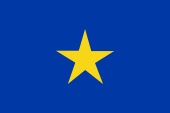 |
1877–1908, |
 |
1908–1960, |
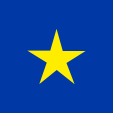 |
1908–ca.1950(?), |
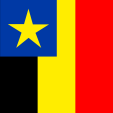 |
ca.1950(?)–1960, |
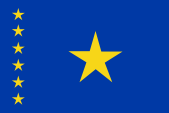 |
1960–1963, |
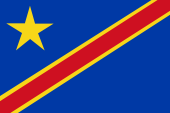 |
1963–1966, Nationalflagge – national flag, Seitenverhältnis – ratio = 2:3, Quelle/Source, nach/by: Wikipedia (D) |
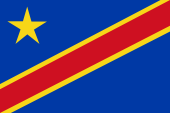 |
1966–1971, Nationalflagge – national flag, Seitenverhältnis – ratio = 2:3, Quelle/Source, nach/by: Wikipedia (D) |
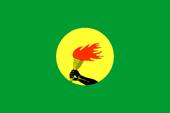 |
1971–1997, |
 |
1997–2003, Nationalflagge – national flag, Seitenverhältnis – ratio = 2:3, Quelle/Source, nach/by: Wikipedia (D)   |
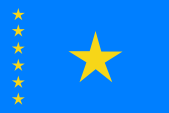 |
2003–2006, Nationalflagge – national flag, Seitenverhältnis – ratio = 2:3, Quelle/Source, nach/by: Wikipedia (D) |
Bedeutung/Ursprung der Flagge – Meaning/Origin of the Flag: |
|
| Die heutige Flagge von Kongo-Kinshasa wurde am 18.02.2006 eingeführt. Eine ähnliche Flagge war bereits zwischen dem 1963 und 1971 in Gebrauch. Die Flagge besteht aus einem hellblauem Flaggentuch mit einem gelben fünfzackigen Stern in der Oberecke und einen roten, gelb geränderten Diagonalstreifen. Als Farbwerte für die Flagge werden angegeben: Hellblau = Pantone 299, Rot = Pantone 186, Gelb = Pantone 107. | The
today's flag of Congo-Kinshasa was introduced on 18th of February in 2006. A
similar flag was already in use between 1963 and 1971. The flag consists of a pale blue bunting with a yellow
five-pointed star in the upper staff quadrant and a red, yellow bordered
diagonal stripe. The colour values given for the flag are: Light blue = Pantone 299, red = Pantone 186, yellow = Pantone 107. |
| Die Farbe Blau soll für den Frieden unter den Völkern des Kongo stehen, das Rot für das Blut der im Kampf um die Freiheit gefallenen Kämpfer, das Gold steht für Wohlstand. Der Stern symbolisiert die Einheit des Landes und der Diagonalstreifen die Zukunft. | The colour blue should stand for peace among the peoples of the Congo, the red for the blood of the fighters who died in the fight for freedom, the gold stands for prosperity. The star symbolizes the unity of the country and the diagonal stripe symbolize the future. |
| Die Flagge des Kongo Freistaates, die bereits im Jahre 1877 angeblich von Henry Morton Stanley geschaffen wurde, war blau mit einem großen gelben Stern in der Mitte. Sie wurde auch während der belgischen Kolonialzeit beibehalten. | The flag
of the Congo Free State - which was already and ostensibly created in the
year 1877 by Henry Morton Stanley - was blue with a big yellow star in the
middle. It was also maintained during the Belgian colonial time. |
| Bei Erlangung der Unabhängigkeit am 30. September 1960 wurden auf der bisherigen Flagge sechs kleine gelbe Sterne für die Provinzen am Flaggenmast hinzugefügt. | In context with the achievement of the independence on the 30th of June 1960 were added on the hitherto flag six little yellow stars for the provinces near the flagstaff. |
| So zeigte die Flagge damals ein blaues Flaggentuch mit einem großen gelben fünfzackigen Stern in der Mitte und sechs kleineren gelben fünfzackigen Sterne am Flaggenmast. Der große gelbe Stern steht für die Nation und die kleinen Sterne für die damaligen sechs Provinzen. Das Blau symbolisierte damals den Himmel über dem Land und das Gelb die Bodenschätze des Landes. Diese Flagge war bis zum 30.06.1963 in Gebrauch, wurde aber nach der Zaire-Ära (1971–1997) erneut eingeführt und bis 2003 verwendet und in Hellblau noch einmal bis 2006. | In
this way the flag showed at
that point of time a blue bunting with a big yellow five-pointed star in the
middle and six smaller yellow five-pointed stars on the flagstaff. The big yellow star stood for the nation and the small stars for the then six provinces. The colour blue symbolized at that point in time the heaven above the country and the yellow the natural resources of the country. This flag was in use until the 30th of June in 1963, but was re-introduced after the Zaire era (1971–1997) and was used until 2003 and was used again in light blue until 2006. |
| Da zwischen den Jahren 1960 und 1963 zwei Provinzen den Staat Kongo verlassen hatten, hätte man in dieser Zeit zwei Sterne von der bisherigen Flagge entfernen müssen. Um solchen Tendenzen vorzubeugen, und auch um die Rolle der Provinzen in den Hintergrund zu drängen, wurde eine völlig neue Flagge geschaffen. | Because of that, that two provinces leaved the state of Congo between the years 1960 and 1963, they had really to remove in this time two stars from the hitherto valid flag. To prevent such tendencies and even to push aside the role of the province in the background was created a complete new flag. |
| Diese neue Flagge wurde am 01.07.1963 angenommen, und 1966 ein klein wenig verändert. Das Flaggentuch zeigte wieder ein dunkles Blau und nur einen einzigen gelben Stern in der Oberecke am Mast und einem roten, gelb geränderten Diagonalstreifen. | This new flag was adoped on the 1st of July in 1963 and in 1966 changed a little bit. The bunting showed a dark blue again and only one single yellow star in the upper staff quadrant and a red, yellow bordered diagonal stripe. |
| Diese Flagge wurde zur Vorlage für jene Flagge, die 2006 in Hellblau eingeführt wurde. | This flag became the template for the flag, which was introduced in light blue in 2006. |
| Zunächst aber trat am 24. November 1971 eine grüne Flagge mit einer goldenen Scheibe an deren Stelle, darauf ein brauner Arm, der eine braune Fackel mit roter Flamme hält. Sie wurde im Zusammenhang mit der Umbenennung des Landes in "Zaire" angenommen. Arm und Fackel symbolisieren den revolutionären Geist der Nation, die rote Flamme ehrt die Märtyrer des Unabhängigkeitskampfes. Grün ist Symbol der Zukunftshoffnung. Diese Flagge basierte auf der Parteiflagge der MPR (Mouvement Populaire de la Revolution), enthielt aber auch die panafrikanischen Farben Rot, Gelb und Grün (siehe → Äthiopien). | First, however, on
24th of November in 1971, a green flag with a golden disc stood in its place,
thereupon a brown arm which holds a brown torch with a red
flame. It was adoped in context with the rename of the country in "Zaire". Arm and torch symbolized the revolutionar spirit of the nation, the red flame honors the martyrs of the struggle for independence. Green is the symbol of the hope for future. That flag based on thr party flag of the MPR (Mouvement Populaire de la Revolution), but also contained the Panafrican Colours red, yellow and green (look → Ethiopia). |
| Quelle/Source: Wikipedia (D), Wikipedia (EN), Die Welt im bunten Flaggenbild, Flaggen Wappen Hymnen, Die Welt der Flaggen | |
Wappen – Coat of Arms: |
|
 |
1885–1908, Wappen des Kongo-Freistaats – coat of arms of Kongo Free State, Quelle/Source, nach/by: Wikipedia (FR) |
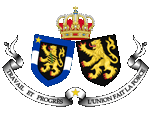 |
1908–1960, Wappen von Belgisch-Kongo – coat of arms of Belgian Congo, Quelle/Source: Lesser coat of arms of Belgium.svg: Katepanomegas und Sodacan gemeinsam; Schild Kongo Freistaat.svg: MS05L.MS05L at de.wikipedia [CC BY-SA 3.0], via Wikimedia Commons |
 |
1960–1963, Wappen von Kongo-Léopoldville – coat of arms of Congo Léopoldville, Quelle/Source: MS05L [CC BY-SA 3.0], via Wikimedia Commons |
 |
1963–1971, Wappen von Kongo-Kinshasa – coat of arms of Congo-Kinshasa, Quelle/Source: Coats_of_arms_of_Zaire_1971-1997.svg: Tadpole9derivative work: MS05L [Public domain], via Wikimedia Commons |
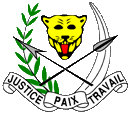 |
1971–1997, Wappen von Zaire – coat of arms of Zaire, Quelle/Source, nach/by: Corel Draw 4 |
 |
1997–1999, Wappen von Kongo-Kinshasa – coat of arms of Congo-Kinshasa, Quelle/Source: Coats_of_arms_of_Zaire_1971-1997.svg: Tadpole9derivative work: MS05L [Public domain], via Wikimedia Commons |
 |
1999–2003, Wappen von Kongo-Kinshasa – coat of arms of Congo-Kinshasa, Quelle/Source: via Wikimedia Commons |
 |
2003–2006, Wappen von Kongo-Kinshasa – coat of arms of Congo-Kinshasa, Quelle/Source: via Wikimedia Commons |
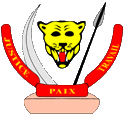 |
seit/since 2006, Wappen von Kongo-Kinshasa – coat of arms of Congo-Kinshasa, Quelle/Source, nach/by: Wikipedia (EN) |
Bedeutung/Ursprung des Wappens – Meaning/Origin of the Coat of Arms: |
|
| Am 18.02.2006 wurde das heutige Wappen eingeführt. Es zeigt wieder den bis 1997 verwendeten Leopardenkopf, begleitet von einem Elefantenstoßzahn und einem Speer. Auf einem Sockel ein Spruchband mit dem Motto des Landes: "Justice, Paix, Travail" → "Gerichtsbarkeit, Frieden, Arbeit". | On 18th
of February 2006 the today's coat of arms was introduced. It shows again the until
1997 used leopard-head escorted by an elephant-tusk and a spear. On a pedestal a banner with the motto of the country: "Justice, Paix, Travail" → "Justice, Peace, Work". |
| Das Wappen von Zaire zeigte den Kopf eines Leoparden, der von einem Palmenzweig und einem Elefantenstoßzahn umgeben war. Im Vordergrund kreuzten sich ein Pfeil und ein Speer. Unterhalb ein Spruchband mit dem Motto des Landes: "Justice, Paix, Travail" → "Gerichtsbarkeit, Frieden, Arbeit". | The coat
of arms of Zaire showed a head of a leopard, which was surrounded by a
palm-twig and an elephant's tusk. In the foreground crossed an arrow and a
spear. Below a banner with the motto of the country: "Justice, Paix, Travail" → "Justice, Peace, Work". |
| Quelle/Source: Wikipedia (D) | |
Flugzeugkokarde – aircraft roundel: |
|
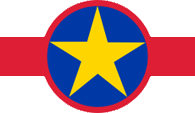 |
seit/since 1997, Flugzeugkokarde – aircraft roundel Quelle/Source, nach/by: Wikipedia (EN) |
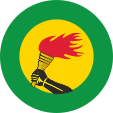 |
1992–1997, Flugzeugkokarde – aircraft roundel, Zaire, Quelle/Source, nach/by: Wikipedia (EN) |
Landkarten – Maps: |
Die Lage des Landes – position of the Country: |
Kongo – Congo: |
|
|
Zahlen und Fakten – Numbers and Facts: |
|
|
|
|
|
|
|
|
|
|
|
|
|
|
|
|
|
|
|
Geschichte: |
| 15. Jhd.
bis 19. Jhd. · Kongoreich im Westen, Lubareich und Lundareich in der Mitte
des heutigen Kongo-Kinshasa 18. Jhd. bis 19. Jhd. · Kubareich in der Mitte des heutigen Kongo-Kinshasa 19. Jhd. · Kassongo-Reich im Osten des heutigen Kongo-Kinshasa, der arabische Einfluss dehnt sich von Osten kommend bis an den Kongo-Fluss aus 1876 · der Forscher Henry Morton Stanley beginnt große Ländereien im Kongobecken für König Leopold II. von Belgien zu erwerben 1884–1885 · Berliner Kongokonferenz, Anerkennung der Besitzungen Leopolds II. als Kongo-Freistaat durch die europäischen Mächte 1891 · Katanga kommt zum Kongo-Freistaat 1908 · Auflösung des Kongo-Freistaats, Errichtung der unmittelbaren belgischen Kolonialverwaltung, Umbenennung in Belgisch-Kongo 1920 · die Territorien Ruanda und Urundi, Teile des ehemaligen Deutsch-Ostafrika, werden gemäß dem Versailler Diktat als Mandat des Völkerbundes der Kolonie Belgisch-Kongo angeschlossen 30.06.1960 · Unabhängigkeit als Republik Kongo für das frühere Belgisch-Kongo, wenig später Armeerevolte, die Provinzen Katanga und Kasai erklären sich für unabhängig, Bürgerkrieg bis 1965 1961 · Umbenennung in Bundesrepublik Kongo 1962 · der Staat Kasai kapituliert 1963 · UN-Truppen erobern den Staat Katanga 1964 · Abzug der UN-Truppen, Umbenennung in Demokratische Republik Kongo 25.11.1965 · General Joseph-Désiré Mobutu putscht sich an die Macht 1966 · Umbenennung vieler Städte mit europäischen Namen (z.B. Stanleyville in Kisangani) 1967 · Gründung der Einheitspartei „Revolutionäre Volksbewegung“ (MPR), neue Verfassung, Ein-Parteien-System 23.10.1971 · Umbenennung des Landes von Kongo in Republik Zaire, Umbenennung von Katanga in Shaba 1977 · katangische Rebellen fallen von Angola aus nach Shaba (Katanga) ein 1978 · katangische Rebellen fallen erneut von Angola aus nach Shaba (Katanga) ein 1991 · soziale Unruhen, Einführung des Mehr-Parteien-Systems 1993 · Gouverneur Gabriel Kyungu Wa Kumwanza veranlasst offiziell die Rückbenennung der Provinz in Katanga, und erklärt diese für autonom 1996 · Kämpfe zwischen Hutu und Tutsi, Beginn des Bürgerkrieges gegen Mobutu 1997 · Sturz des Joseph-Désiré Mobutu durch Militär und Stammesmilizen, Mobutu geht ins Exil nach Frankreich und stirbt, neuer Staatschef wird Laurent Désiré Kabila, Umbenennung des Landes von Zaire in Kongo (Demokratische Republik), die Tutsi-Milizen wenden sich gegen Kabila 30.06.1998 · Einführung des Kongolesischen Franc 02.08.1998 · Tutsi-Milizen und Truppen aus Ruanda und Uganda beginnen ein bis heute anhaltenden offenen Krieg gegen die Zentralregierung 16.01.2001 · Präsident Laurent Desiré Kabila wird ermordet, Nachfolger wird sein Sohn Joseph Kabila 2015 · Katanga wird auf Beschluss des Präsidenten von Kongo-Kinshasa aufgelöst und in vier einzelne Provinzen aufgeteilt (Haut-Katanga, Haut-Lomami, Lualaba, Tanganyika) und per Gesetz zur Neuregelung der Provinzen umgesetzt 2019 · Joseph Kabila wird abgewählt |
History: |
| 15th
cent. to 19th cent. · Congo Empire in the west, Luba Empire and Lunda Empire
in the middle of the today's Congo-Kinshasa 18th cent. to 19th cent. · Kuba Empire in the middle of the today's Congo Kinshasa 19th cent. · Kassongo in the east of the today's Congo-Kinshasa, the Arabic influence expands from the east to the Congo River 1876 · the explorer Henry Morton Stanley begins to purchase large properties in the Congo Basin for king Leopold II. of Belgium 1884–1885 · Berlin Congo Conference, recognition of the possessions of Leopold II. as Congo Freestate by the european powers 1891 · Katanga comes to the Congo Freestate 1908 · dissolution of the Congo Freestate, establishment of a direct Belgian colonial administration, rename in Belgian Congo 1920 · the territories Ruanda and Urundi, components of the former German East Africa, get incorporated to the Colony of Belgian Congo in accordance with the Versailles Dictate as a mandate of the League of Nations 30th of June 1960 · independence for the former Belgian Congo as Republic of Congo, few times later army revolt, the provinces Katanga and Kasai declare itself for independent, civil war to 1965 1961 · renamed in Federal Republic of Congo 1962 · the State of Kasai surrenders 1963 · UN troops invade the State of Katanga 1964 · withdrawal of the UN troops, renamed in Democratic Republic of Congo 25th of November 1965 · General Joseph-Désiré Mobutu coups hisself to the power 1966 · rename of many towns with European names (e.g. Stanleyville in Kisangani) 1967 · foundation of the unity's party „Revolutionar People's Movement“ (MPR), new constitution, single-party-system 23rd of October 1971 · rename of the country from Congo in Republic of Zaire, rename of Katanga in Shaba 1977 · Katangian rebels invade from Angola to Shaba (Katanga) 1978 · Katangian rebels invade again from Angola to Shaba (Katanga) 1991 · social riots, introduction of the multi-party-system 1993 · Governor Gabriel Kyungu Wa Kumwanza prompts officially the rename of the province in Katanga and declares it for autonomous 1996 · struggles between Hutu and Tutsi, begin of the civil war against Mobutu 1997 · fall of the Joseph-Désiré Mobutu by armed forces and tribal militias, Mobutu goes in exile to France and dies, new Chief of the State becomes Laurent Désiré Kabila, rename of the country from Zaire to Congo (Democratic Republic of), the Tutsi militias struggle against Kabila now 30th of June 1998 · introduction of the Congolese Franc 2nd of August 1998 · Tutsi militias and troops from Rwanda and Uganda start an until today maintaining open war against the central government 16th of January 2001 · president Laurent Desiré Kabila gets assassinated, successor is his son Joseph Kabila 2015 · Katanga is dissolved by decision of the President of Congo-Kinshasa and divided into four individual Provinces (Haut-Katanga, Haut-Lomami, Lualaba, Tanganyika) and implemented by law on the new regulation of the provinces 2019 · Joseph Kabila is voted out |
| Quelle/Source: Atlas zur Geschichte, Wikipedia (D), Discovery '97, Weltgeschichte, Länder der Erde |
Ursprung des Landesnamens – Origin of the Country's Name: |
|
| "Kong" heißt in der Sprache der Bantu "Berg". Offenbar wurde der Name "Berg" durch die Einheimischen auf einen ganzen Fluss übertragen, der seine Quelle tatsächlich in den Bergen hat. | "Cong"
means in the language of the Bantu "Mountain". Obviously the name "Mountain" was given by the indigenous people for the whole river, indeed, its source is in the Mountains. |
| Offiziell werden die beiden Kongos gerne durch den Zusatz "Republik" oder "Demokratische Republik" unterschieden. Das ist wenig zweckmäßig, da sich solche Bezeichnungen sehr schnell ändern können und außerdem nicht die staatsrechtlichen Realitäten wiedergegeben werden. Die Regelung die beiden Kongos durch den Anhang des Namens der Hauptstadt auseinanderzuhalten ist weit verbreitet, weitaus zweckmäßiger und hat sich in der Vergangenheit bewährt. | The both
Congos get popularly and officially differentiated by the supplement
"Republic" or "Democratic Republic". This is not functional, because such designation could change very quickly and moreover they do not reflect the state-legal realities. The adjustment to differentiate the both Congos by attach of the name of the capital it wide spreaded, far purposefuller and is proven in the past. |
| Die Bezeichnung "Zaire" war keine Wortschöpfung von Mobutu, sondern Mobutu hatte auf eine alte – bei den Bantu im 15. Jahrhundert gebräuchliche – Bezeichnung für den Unterlauf des Flusse Kongo zurückgegriffen, um den Landesnamen authentischer und ursprünglicher erscheinen zu lassen. "Zaire" leitet sich ab aus dem Bantu-Wort "n'zadi", was "großes Wasser" heißt. | The
designation "Zaire" was not a word-creation of Mobutu, but Mobutu remembers
an old – from the Bantu in the 15th century used – designation for the upper
part of the Congo River. He wanted to characterize the name of the country more authentical and more original. "Zaire" derives from the Bantu word "n'zadi", what means "big water". |
| Quelle/Source: Handbuch der geographischen Namen, Volker Preuß | |